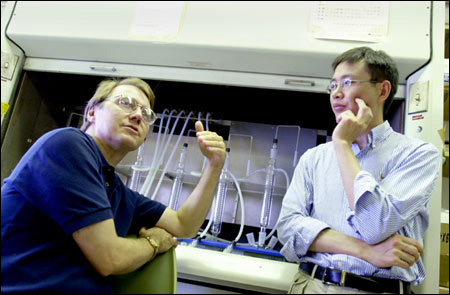Australian shale tells tale of layered seas:
Oxygen-starved depths, oxygenated surface revealed by rock chemistry

The Earth’s ancient oceans were very different from today’s, with oxygen-starved depths beneath oxygenated surface waters, Harvard researchers found in a study that provides clues about the Earth’s environment 1.5 billion years ago.
Their results present quite a different picture from present times, in which oceans have oxygen-rich waters from top to bottom and are capable of supporting large animal life even in their depths.
The findings are important not just for what they tell us about prehistoric oceans, but also for what they tell us about oxygen in the air at the time. Scientists believe oxygen in the Earth’s atmosphere rose to today’s levels in two distinct jumps, 2.3 billion years ago and at about 800 million years ago.
“This strongly supports the idea that the initial rise in oxygen didn’t bring us to modern levels,” said Andrew Knoll, Fisher Professor of Natural History, who, along with postdoctoral fellow Yanan Shen, and Australian colleague Malcolm Walter, conducted the research. “It tells us that halfway through Earth’s history we still didn’t have an atmosphere we could breathe.”
Knoll, Shen, and Walter have been working to illuminate the Earth’s transition from its lifeless creation to the world we know today, with oxygen-rich skies, and life teeming on land and in the sea. Paleontologists believe life on the early Earth evolved slowly, perhaps because early oxygen levels were just a fraction of what they are today.
The ancient oceans described by the three have a modern analog in today’s Black Sea. The Black Sea has oxygenated upper waters supporting fish and other familiar marine life, but has very low oxygen in the waters below about 200 meters.
Roper River Basin
The researchers searched for evidence of global oxygen levels in black shale taken from the Roper River Basin in Australia’s Northern Territory. The shales were deposited when the area was at the bottom of an ancient sea between 1.5 billion and 1.4 billion years ago.
They reasoned that atmospheric oxygen levels would be reflected in ocean oxygen content, which in turn would be reflected in the chemistry of sedimentary rocks created at the bottom of those seas.
Their work indicates that global oxygen levels 1.5 billion years ago were high enough to penetrate the ocean’s upper layers but still low enough that the oceans weren’t completely oxygenated as they are today. This, in turn, gives evidence that the second jump in global oxygen came later than their study period of 1.5 billion years ago.
“In the ancient Roper seaway, whenever you were in relatively shallow water, up to maybe 50 meters to 100 meters, there was oxygen. Whenever you dipped into deeper waters, you were in environments without oxygen,” Knoll said.
Paleontologists suspect that the second increase in global oxygen preceded a critical period for life on Earth called the “Cambrian Explosion.” That event, between about 540 million and 520 million years ago, is when all modern animal phyla first appear in the fossil record, including trilobites, the earliest fossils with hard shells.
Following the pyrite and sulfate trails
By examining the chemical makeup of shale taken from different areas in the basin, the researchers were able to reconstruct the conditions under which the shale was created.
The first thing they examined was the amount and distribution of iron in the shale. In shales deposited beneath oxygen-starved waters, much of this iron accumulates as pyrite, or fool’s gold. Pyrite is a combination of iron and sulfur, and forms more quickly in environments lacking oxygen and rich in hydrogen sulfide than it does in environments with more oxygen and less hydrogen sulfide like today’s oceans.
Using shale samples formed at different depths in the ancient sea, the researchers were able to create an oxygen profile from the shallow coastal waters to the deep-sea bottom.
What they found is that the shallow coastal waters were oxygenated while the deeper waters of the basin were anoxic, or lacked oxygen. Since the surface waters across the basin were exposed to same source of oxygen as the coastal waters – the atmosphere – they concluded that the upper waters of the entire basin were oxygenated.
“This is clearly a much different ocean than what we have today,” Shen said.
Their second analysis gave another indication that atmospheric oxygen levels were lower 1.5 billion years ago than they are today. The researchers looked at isotopes of sulfur bound into the pyrites in the Roper shale to get an idea of how much sulfate was dissolved in the ancient seas. They found that Roper waters contained less sulfate than modern oceans. Because virtually all the oceans’ sulfate comes originally from land, where it is released through a chemical reaction involving oxygen, this again points to less oxygen in the atmosphere.
Their results apply specifically to conditions at the Roper Basin, but Knoll suspects that the basin is broadly representative of oceanic conditions at the time.
Shen and Knoll are continuing their research on the subject this summer, but heading in different directions. Shen plans to visit Canada’s Mackenzie Mountains and move forward in time by examining sedimentary rocks that date to before the critical Cambrian Explosion. Knoll will head to South Africa to examine rocks from a basin believed to be 2.5 billion years old, or about the time that scientists think the first increase in global oxygen levels occurred.
“We’re going to divide and conquer, let’s hope,” Knoll said.




